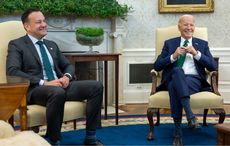This St Patrick’s Day, new Sinn Fein president Mary Lou McDonald traveled to the U.S. in an effort to lobby Washington politicians and woo Irish-American donors — just as former Sinn Fein leader Gerry Adams and other party leaders have done for the past two decades.
Adams accompanied McDonald as did Northern Ireland former Deputy First Minister Michelle O'Neill.
The official handoff from Adams to Mary Lou occurred in a packed ballroom in the Sheraton Hotel in midtown at lunchtime on March 16th. After 34 years Adams was stepping aside and while the handoff had already occurred in Ireland, Irish Americans in their hundreds gathered to witness the historic move also
Speaking to the packed audience of about 400 supporters McDonald said the goal of her visit is “to set out my style as the new leader” and “to come and say hello” to Sinn Fein’s allies in Washington and its Irish-American donors.
During a speech in New York on Friday, Adams acknowledged McDonald and her vice president, Michelle O’Neill: “We have been blessed with a generational transition. And it is a matter of pride for me that our party chose two women to lead us because women for too long have been written out of our history.”
Read More: Sinn Fein’s Mary Lou says hello to America in exclusive interview
McDonald told American supporters: “Gerry’s shoes cannot be filled, but I have my shoes, Michelle’s got her boots and you’re all going to need your sneakers. But we’re in this together.”
.@MaryLouMcDonald marches with New York Councillors. St. Patrick's Day. pic.twitter.com/EIsiBmlrmQ
— Sinn Féin (@sinnfeinireland) March 17, 2018
McDonald told The New York Times that she hoped the support from America could help the party manage two current crisis in Northern Ireland: the collapse of the North’s power-sharing government and the British exit from the EU.
She said she believes Irish-Americans could play “a very active role” in helping her navigate Britain’s exit, and she thinks the turmoil of Brexit could ultimately lead to the the reunification of Ireland.
“The Good Friday Agreement provides for a referendum on Irish unity,” she said, referring to the 1998 peace deal. “My objective is to achieve that referendum, to win that referendum in a context of not triumphalism or certainly not coercion but in a spirit of friendship and consensus and change and modernity and moving forward.”
Standing room only to hear @MaryLouMcDonald address the Friends of Sinn Féin in New York. pic.twitter.com/nx5yvTvore
— Sinn Féin (@sinnfeinireland) March 16, 2018
The New York Times reports that Irish-American support has been crucial to the success of Sinn Fein, now the third-largest party in the Republic of Ireland and the second largest in Northern Ireland. Since 1994, when the party began fundraising in the U.S., American donors have generously backed Sinn Fein and party leaders says the U.S. donors have also been an important part of the peace process.
In 2015, The Irish Times reported that since 1994, Sinn Fein had raised $12 million in the U.S.
Aontacht thar gach ni. Unity above all else. St. Patrick's Day Breakfast for American Labour leaders. New York City. pic.twitter.com/JWbxOn2LBQ
— Sinn Féin (@sinnfeinireland) March 17, 2018
“The 15,000 donations received by Friends of Sinn Féin, the party’s US fundraising arm, between 1995 and 2014 are the fruits of a fundraising effort unmatched by any other Irish political party in the U.S. in modern times,” The Irish Times reported.
Irish American philanthropist Chuck Feeney, who donated $780,000 personally and through two of his companies, was the party’s biggest donor. His donation funded the establishment of a Friends of Sinn Fein office in Washington DC.
Since the 2015 report, the party has raised more than $922,00 here.
Read More: New Sinn Fein leader says the party will see a united Ireland
“In America that’s nothing, but over there it’s huge,” said Larry Downes, who led the party’s U.S. fundraising from 1995 to 2012.
According to experts, the success of Sinn Fein in the U.S. reflect “longstanding dynamics within elements of the Irish diaspora.”
Former Irish diplomat Ted Smyth said: “There has been the tradition since at least 1916 of the Irish in America being more militant than the Irish in Ireland” — which he attributes to a feeling among earlier generations of immigrants that “they were exiled from Ireland, in a sense, because of British colonialism.”
St Patrick’s Day in the U.S., where the holiday is widely celebrated even by non-Irish, has traditionally include a series of events for Irish leaders.




Comments